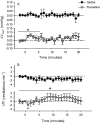Treatment with the selective serotonin reuptake inhibitor, fluoxetine, attenuates the fish hypoxia response
- PMID: 27499056
- PMCID: PMC4976378
- DOI: 10.1038/srep31148
Treatment with the selective serotonin reuptake inhibitor, fluoxetine, attenuates the fish hypoxia response
Abstract
The selective serotonin reuptake inhibitor (SSRI) fluoxetine (FLX), the active ingredient of the antidepressant drug Prozac, inhibits reuptake of the neurotransmitter, serotonin (5-HT; 5-hydroxytryptamine), into cells by the 5-HT transporter (SERT). Given the role of 5-HT in oxygen detection and the cardiovascular and ventilatory responses of fish to hypoxia, we hypothesized that treatment of the Gulf toadfish, Opsanus beta, with FLX would interfere with their response to hypoxia. Toadfish treated intra-arterially with 3.4 μg.g(-1) FLX under normoxic conditions displayed a transient tachycardia and a biphasic caudal arterial blood pressure (PCA) response that are in direct conflict with the typical hypoxia response. Fish injected intraperitoneally with FLX under normoxia had resting cardiovascular and ventilatory parameters similar to controls. Upon exposure to hypoxia, control toadfish exhibit a significant bradycardia, reduction in PCA and an increase in ventilatory amplitude (VAMP) without any changes in ventilatory frequency (fV). Fish treated IP with 10 μg.g(-1) FLX showed an interference in the cardiovascular and ventilatory response to hypoxia. Interestingly, when treated with 25 μg.g(-1) FLX, the bradycardia and VAMP response to hypoxia were similar to control fish while the PCA response to hypoxia was further inhibited. These results suggest that SERT inhibition by FLX may hinder survival in hypoxia.
Figures






Similar articles
-
Does fluoxetine exposure affect hypoxia tolerance in the Gulf toadfish, Opsanus beta?Aquat Toxicol. 2018 Jun;199:55-64. doi: 10.1016/j.aquatox.2018.03.023. Epub 2018 Mar 23. Aquat Toxicol. 2018. PMID: 29609092
-
Molecular and functional characterization of the Gulf toadfish serotonin transporter SLC6A4.J Exp Biol. 2018 Apr 6;221(Pt 7):jeb170928. doi: 10.1242/jeb.170928. J Exp Biol. 2018. PMID: 29487159
-
Fluoxetine treatment affects nitrogen waste excretion and osmoregulation in a marine teleost fish.Aquat Toxicol. 2009 Nov 8;95(2):164-71. doi: 10.1016/j.aquatox.2009.10.015. Aquat Toxicol. 2009. PMID: 20225343
-
Effects of the antidepressant fluoxetine on the subcellular localization of 5-HT1A receptors and SERT.Philos Trans R Soc Lond B Biol Sci. 2012 Sep 5;367(1601):2416-25. doi: 10.1098/rstb.2011.0361. Philos Trans R Soc Lond B Biol Sci. 2012. PMID: 22826342 Free PMC article. Review.
-
Speculations on difference between tricyclic and selective serotonin reuptake inhibitor antidepressants on their cardiac effects. Is there any?Curr Med Chem. 1999 Jun;6(6):469-80. Curr Med Chem. 1999. PMID: 10213794 Review.
Cited by
-
Long-read de novo genome assembly of Gulf toadfish (Opsanus beta).BMC Genomics. 2024 Sep 18;25(1):871. doi: 10.1186/s12864-024-10747-8. BMC Genomics. 2024. PMID: 39289604 Free PMC article.
References
-
- Brooks B. W. Fish on Prozac (and Zoloft): ten years later. Aquat. Toxciol. 151, 61–67 (2014). - PubMed
-
- Morando M. B., Medeiros L. R. & McDonald M. D. Fluoxetine treatment affects nitrogen waste excretion and osmoregulation in a marine teleost fish. Aquat. Toxicol. 95, 164–171 (2009). - PubMed
-
- McDonald M. D., Gonzalez A. & Sloman K. A. Higher levels of aggression are observed in socially dominant toadfish treated with the selective serotonin reuptake inhibitor, fluoxetine. Comp. Biochem. Physiol. 153C, 107–112 (2011). - PubMed
-
- Altamura A. C., Moro A. R. & Percudani M. Clinical pharmacokinetics of fluoxetine. Clin. Pharmacokinetic 26, 201–214 (1994). - PubMed
-
- Hiemke C. & Härtter S. Pharmacokinetics of selective serotonin reuptake inhibitors. Pharmacol. Therap. 85, 11–28 (2000). - PubMed
Publication types
MeSH terms
Substances
Grants and funding
LinkOut - more resources
Full Text Sources
Other Literature Sources

